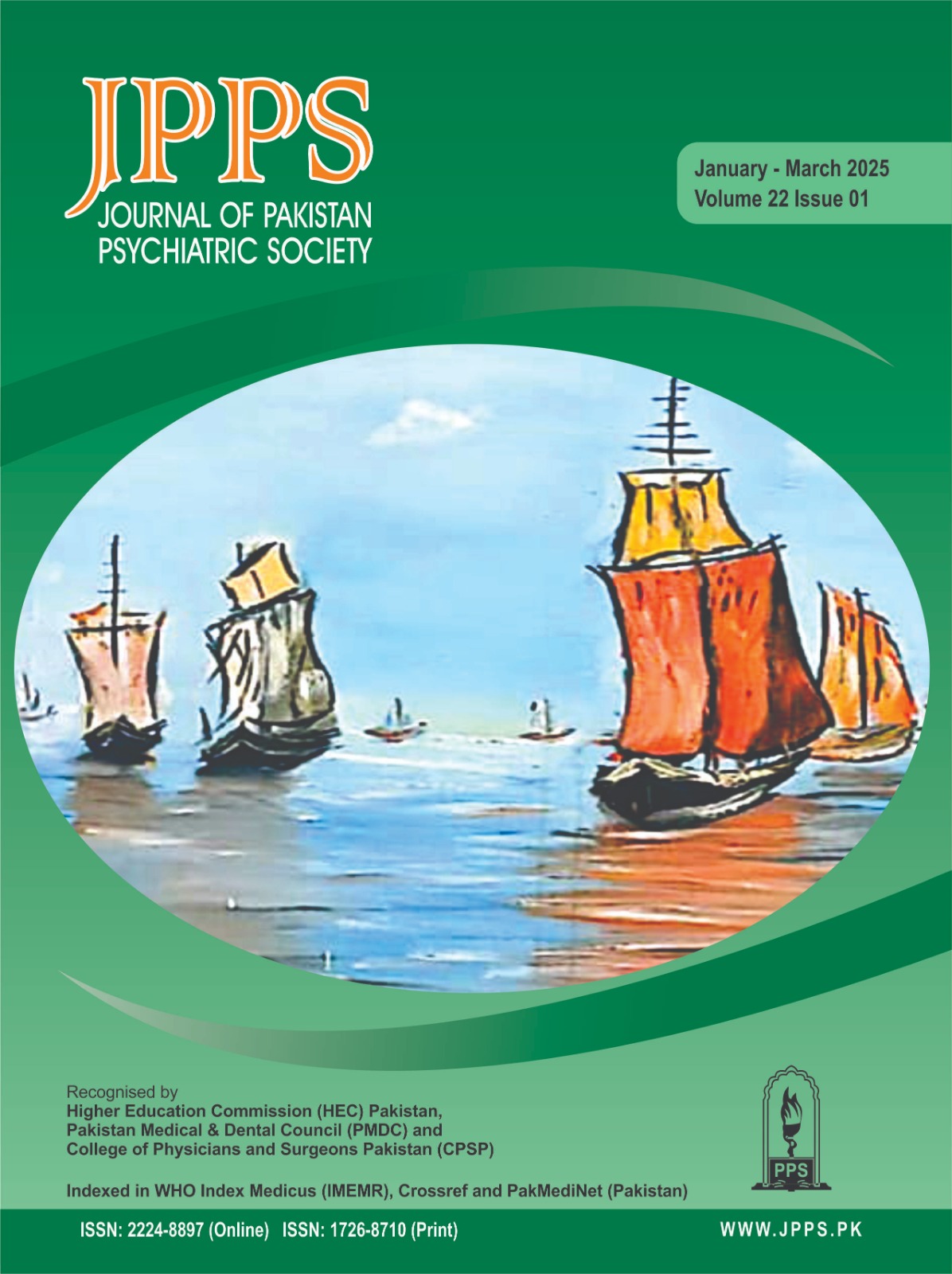EXPLORING THE RELATIONSHIP BETWEEN CLASSROOM CLIMATE, ACADEMIC SATISFACTION, AND LIFE SATISFACTION OF UNIVERSITY STUDENTS
Abstract
OBJECTIVE
To assess the relationships between the classroom climate, academic satisfaction, and life satisfaction of university students in Pakistan.
STUDY DESIGN
Cross-sectional study
PLACE AND DURATION OF STUDY
The study was conducted at the Institute of Professional Psychology at Bahria University Karachi, Pakistan, from May to October 2022.
METHOD
A sample of 271 university students, aged 18 to 45 were approached via convenience sampling. The College and University Classroom Environment Inventory was administered to measure the classroom climate while the Satisfaction with Life Scale was utilized to evaluate academic and life satisfaction.
RESULTS
The study found a significant positive correlation between Classroom Climate (CC) and both Academic Satisfaction (r = .26, p < .01) and Life Satisfaction (r = .18, p < .01). Regression analysis showed that CC explained 35% of the variance in Academic Satisfaction (R² = .35, p < .001) and 32% in Life Satisfaction (R² = .32, p < .001). Graduate students reported higher academic satisfaction and better classroom climate perception than undergraduates (F = 10.95, p < .05), while doctoral students exhibited lower satisfaction levels.
CONCLUSION
The findings show how crucial the classroom climate is in influencing students' academic satisfaction and life satisfaction. An encouraging and dynamic classroom climate promotes better learning experiences and wellbeing.
Downloads
References
Pakistan [Internet]. UNESCO Institute of Statistics; 2017 [cited 10th July 2024]. Available from: https://uis.unesco.org/en/country/pk
Barr JJ. Developing a Positive Classroom Climate [Internet]. IDEA; 2016 [cited 10th July 2024]. Available from: https://ideacontent.blob.core.windows.net/content/sites/2/2020/01/PaperIDEA_61.pdf
Fraser BJ, Treagust DF. Validity and use of an instrument for assessing classroom psychosocial environment in higher education. High Educ. 1986;15:37–57. doi: https://doi.org/10.1007/BF00138091
Graham SW, Gisi SL. Adult undergraduate students: What role does college involvement play? NASPA Journal. 2000; 38(1):99–121. doi: https://doi.org/10.2202/1949-6605.1122
Chionh YH, Fraser BJ. Classroom environment, achievement, attitudes and self-esteem in geography and mathematics in Singapore. International Research in Geographical and Environmental Education. 2009;18(1), 29–44. doi: https://doi.org/10.1080/10382040802591530
Hernon P, Altman E. Assessing service quality: Satisfying the expectations of library customers, 2nd ed. Chicago, IL: American Library Association; 2010.
Green HJ, Hood M, Neumann DL. Predictors of Student Satisfaction with University Psychology Courses: A Review. Psychology Learning & Teaching. 2015;14(2):131-146. doi: https://doi.org/10.1177/1475725715590959
Diener E. Positive psychology: past, present, and future. In: Snyder CR, Lopez SJ, editors. The Oxford Handbook of Positive Psychology. 2nd ed. Oxford (UK): Oxford University Press; 2009. p. 7–12.
Loewe N, Bagherzadeh M, Araya-Castillo L, Thieme C, Batista-Foguet JM. Life Domain Satisfactions as Predictors of Overall Life Satisfaction Among Workers: Evidence from Chile. Soc Indic Res. 2014;118(1):71-86. doi:10.1007/s11205-013-0408-6
Butt BZ, Ur Rehman K. A study examining the student’s satisfaction in higher education. Procedia-Social and Behavioral Sciences. 2010; 2(2):5446-5450. doi: https://doi.org/10.1016/j.sbspro.2010.03.888
Malik RH, Rizvi AA. Effect of Classroom Learning Environment on Students' Academic Achievement in Mathematics at Secondary Level. Bulletin of Education and Research. 2018;40(2):207-218.
Woo CW, Whitfield TS, Britt LL, Ball TC. Students’ Perception of the Classroom Environment: A Comparison between Innovative and Traditional Classrooms. J Scholarsh Teach Learn. 2022;22(1): 31-47.
doi: https://doi.org/10.14434/josotl.v22i1.30735
Merino MD, Privado Zamorano J, Durán R. Satisfaction with Life Scale (SWLS) adapted to work: Psychometric Properties of the Satisfaction with Work Scale (SWWS). Anales de Psicología / Annals of Psychology. 2021;37(3): 557–566. doi: https://doi.org/10.6018/analesps.430801
de Almeida Cardoso AG, de Carvalho MV, de Almeida Silva MIA, et al. Psychometric properties of the online Satisfaction with Life Scale in university students from a low-income region. Psicol Reflex Crit. 2023;36(1):12. doi:10.1186/s41155-023-00254-2
Aldridge JM, McChesney K, Afari E. Associations between school climate and student life satisfaction: resilience and bullying as mediating factors. Learning Environments Research. 2020 23(1):129–150.
doi: https://doi.org/10.1007/s10984-019-09296-9
Pawlowska DK, Westerman JW, Bergman SM, Huelsman TJ. Student personality, classroom environment, and student outcomes: A person–environment fit analysis. Learning and Individual Differences. 2014; 36:180–193.
doi: https://doi.org/10.1016/j.lindif.2014.10.005
Lin CH. College Student Personality Traits Related to TOEIC and GEPT. Language Testing in Asia. 2012; 2(4):33-46. doi: https://doi.org/10.1186/2229-0443-2-4-33
Denson N, Loveday T, Dalton H. Student evaluation of courses: what predicts satisfaction? Higher Education Research & Development. 2010; 29(4):339–356. doi: https://doi.org/10.1080/07294360903394466
Logan KA, Crump BJ, Rennie LJ. Measuring the Computer Classroom Environment: Lessons Learned from Using a New Instrument. Learning Environments Research. 2006; 9(1):67-93. doi: https://doi.org/10.1007/s10984-005-9004-2
Suldo SM, Shaffer EJ, Riley KN. A social-cognitive-behavioral model of academic predictors of adolescents’ life satisfaction. School Psychology Quarterly. 2008;23(1):56-69. doi: https://doi.org/10.1037/1045-3830.23.1.56
Garriott PO, Hudyma A, Keene C, Santiago D. Social cognitive predictors of first- and non-first-generation college students' academic and life satisfaction. J Couns Psychol. 2015;62(2):253-263. doi: 10.1037/cou0000066
Sharkas GF, El-Masry R, Abdel-Ghany S, et al. Satisfaction of academic medical staff with integrated medical curriculum: an exploratory multinational survey. BMC Med Educ. 2024;24(1):1483. doi:10.1186/s12909-024-06468-x
Perrone KM, Civiletto CL. The impact of life role salience of life satisfaction. Journal of Employment Counseling. 2004; 41(3):105–116. doi: https://doi.org/10.1002/j.2161-1920.2004.tb00884.x
Lay YF, Khoo CH. between actual and preferred science learning environment at tertiary level and attitudes towards science among pre-service science teachers. Pertanika Journal of Social Sciences & Humanities. 2012;20(4):1117-1142.
Gelber K, Brennan K, Duriesmith D, Fenton E. Gendered mundanities: gender bias in student evaluations of teaching in political science. Austral J Polit Sci. 2022;57(2):199–220. doi: https://doi.org/10.1080/10361146.2022.2043241
Copyright (c) 2025 Journal of Pakistan Psychiatric Society

This work is licensed under a Creative Commons Attribution-NonCommercial 4.0 International License.
Copyright © JPPS. Published by Pakistan Psychiatric Society
Licensing: This work is licensed under Creative Commons Attribution-NonCommercial 4.0 International License
Readers may “Share-copy and redistribute the material in any medium or format” and “Adapt-remix, transform, and build upon the material”. The readers must give appropriate credit to the source of the material and indicate if changes were made to the material. Readers may not use the material for commercial purposes. The readers may not apply legal terms or technological measures that legally restrict others from doing anything the license permits.






.png)









